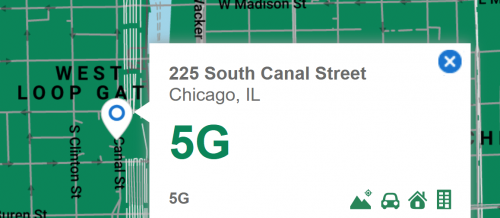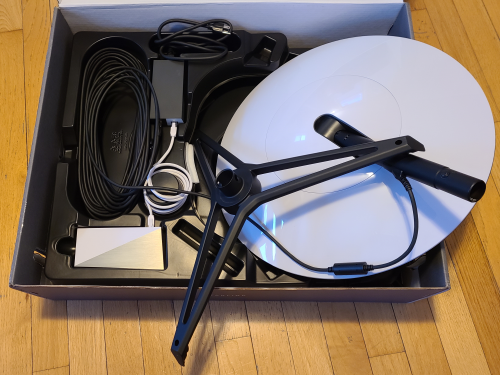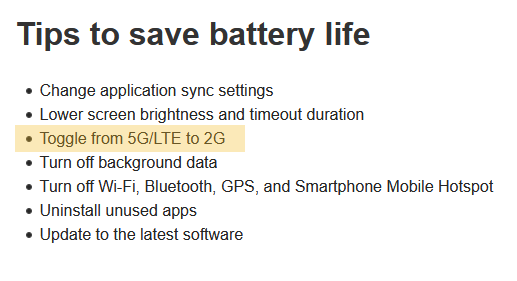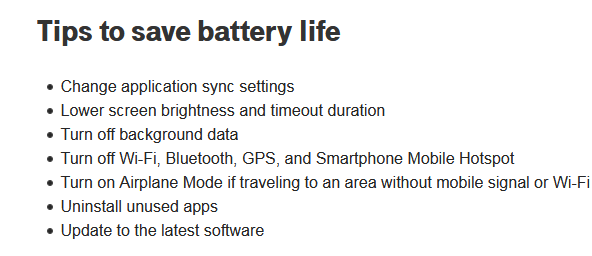4/1/2021 Update: I’m backpedaling from this post. While I’m still unsure what’s going on, T-Mobile likely is grandfathering subscribers into its hotspot plan, contrary to what a customer reported a T-Mobile rep said. From the start, I shouldn’t have taken what the rep said (or allegedly said) as gospel.
Month: March 2021

Verizon Sets New Deadline For 3G Retirement
Major networks are gradually phasing out 3G technology. Today, Verizon announced a new deadline for 3G retirement: December 31, 2022.1
Verizon has set and pushed back deadlines a few times:
I wonder if Verizon always knew it would push back the early deadlines. Even if the early deadlines were artificial, they may have helped transition subscribers off of 3G-only devices:
In today’s announcement, Verizon stated that it would not push back the retirement deadline again. I’m unsure whether Verizon will keep a tiny portion of its 3G network active after 2022 to support business customers using legacy technology.

T-Mobile Connect Increases Data Allotments
T-Mobile recently increased the data allotments on its Connect plans by 500MB. The $15 per month plan now includes 2.5GB of data each month. The data allotment on the $25 plan has been bumped up to 5.5GB.
The data increases are consistent with the commitments T-Mobile made to regulators when pushing for approval of the Sprint/T-Mobile merger. We should see additional 500MB increases each of the next several years. T-Mobile has said the Connect plans will be available without any price increases until at least 2025.
I continue to think the Connect plans offer some of the best value on the market.
H/T to Stettson Doggett who spotted the change to the Connect plans.

Tello’s 5G Isn’t Working With iPhones
Tello is trying to draw attention to its 5G service. Here are a few bits of content fresh from the carrier’s website:



5G was the main topic of one of Tello’s blog posts earlier this month. Here’s what Tello had to say about phone compatibility:
In all of Tello’s materials about 5G, I haven’t seen a mention of a key fact: Tello does not support 5G on iPhones.
This isn’t a small oversight. I’d guess that half of the 5G-compatible phones in the U.S. right now are devices in the iPhone 12 line.
Internal Confusion
It seems not everyone working for Tello is even aware that the carrier doesn’t support 5G on iPhones. This blog comment comes from a Tello representative:

I reached out to Tello’s support asking if the company supports 5G on both iOS and Android devices. Here’s the response I got:
It’s not true. It seems Tello doesn’t have a carrier bundle with Apple. Until that’s figured out, 5G and some other features may remain unavailable for Tello subscribers.
If Tello’s going to make a big deal about its 5G service, the company should make it clear that it does not support the most popular 5G phone.
Thanks to Stetson Doggett who let me know about the issues with 5G on Tello.

NAD Rules Against Boost’s “Unlimited” Plans
Boost Mobile has been offering unlimited plans that include 35GB of regular, full-speed data each month. Subscribers that exceed 35GB of use are throttled to 2G speeds.
I’ve argued that plans where customers can be throttled to snails-pace speeds shouldn’t be labeled “unlimited.” It seems the National Advertising Division (NAD), a self-regulatory body, agrees. The organization just ruled against Boost in a dispute initiated by AT&T. I strongly agree with this excerpt:
Boost’s Marketing
Here’s a screenshot of how the plans appeared on Boost’s website:

The Good
Boost gets a few points of transparency right:
- It’s clear only 35GB of LTE data is included.
- The disclaimer text about throttling to 2G speeds is prominent.
The Bad
- Boost doesn’t say what 2G speeds means.
- The bits about unlimited streaming are utter bullshit.
You can’t stream normal video at 2G speeds (128kbps). You absolutely can’t stream in HD at 128kbps.
Other “Unlimited” Plans
Boost kind of tried to make reasonable discloses about limitations on its unlimited plans. The company’s marketing of it’s “unlimited” plans is far from the most egregious example in the industry. Several other carriers also offer “unlimited” plans with similar throttling policies, including some decent-sized carriers like Mint and Total Wireless. It’ll be interesting to see if the NAD decision leads any companies besides Boost to change their marketing.1

“Premium Data” Is Losing Meaning At T-Mobile
For a while now, Verizon and AT&T have used the phrase “Premium Data” to refer to allotments of especially high-priority data. Subscribers with Premium Data may experience better speeds than other network users during periods of congestion.
In the last month, T-Mobile has started using the phrase “Premium Data” as well. If you go to T-Mobile’s primary page listing the carrier’s plans, you’ll find a table that lists the allotments of premium data on different plans:
- Essentials – 50GB
- Magenta – 100GB
- Magenta Max – Unlimited
Common sense might lead you to think “Premium Data” means the same thing regardless of what plan the Premium Data is attached to. That’s not the case.
Before T-Mobile started using the phrase Premium Data, the company made it clear that the Essentials plan had lower priority data than Magenta plans. The image below comes from T-Mobile’s old plans page:

While T-Mobile updated how plans appear on its website, it doesn’t look like the underlying characteristics of the Essentials plan changed. The plans page still has a disclosure explaining that Essentials customers have lower priority than Magenta customers:
QCI values indicate how traffic is prioritized on LTE networks. In 2020, I found the Essentials plan had a QCI of 7 while the Magenta plan had a QCI of 6 (indicating that the Magenta subscribers have higher-priority data than Essentials subscribers). Once T-Mobile started saying Essentials customers have Premium Data, I ran another QCI test on the plan. I still found a QCI of 7.

Until recently, T-Mobile did a better job disclosing prioritization policies than the other major networks.1 T-Mobile is taking a step back by suggesting the Essentials plan has Premium Data.
As far as I know, Verizon and AT&T only use the phrase “Premium Data” to mean something like: “data prioritized ahead of the data used by a substantial portion of our other customers.” If my understanding of data prioritization on T-Mobile’s network is accurate, Essentials customers receive priority on-par with or worse than most T-Mobile Prepaid, Metro, and Mint Mobile subscribers.
While Essentials subscribers aren’t truly last in line, only a tiny fraction of T-Mobile subscribers have lower priority (e.g., some ultra-heavy data users and people on hotspot connections). It’s silly to call data “premium” when indicating something like: “data that’s not absolutely the lowest priority in the queue.”
As I’ve argued before, consumers ought to have access to better information about prioritization and congestion. The way T-Mobile is using the phrase “Premium Data” is going leave consumers confused. For what it’s worth, I don’t mean to suggest T-Mobile is intentionally hoping to mislead consumers about data priority on the Essentials plan. T-Mobile may have made an honest mistake when coming up with the latest iteration of its plans page.
Hat tip to Stetson Doggett for drawing my attention to this topic.

Starlink First Impressions
I joined Starlink’s beta and recently got the service up and running. While I’ll write a detailed review eventually, I thought I’d share my first impressions now.
Like others in the beta, I paid about $500 for my satellite dish (Dishy as Starlink calls it) and router. Taxes and shipping added about $100 more.
The Dishy, a basic mount, a router, and cords all showed up in one giant box:

Setup was incredibly easy. Here’s how simple Starlink’s instructions were:

Most of the cords were already plugged-in where they belonged. Within about 15 minutes of opening the box, I connected a computer over Wi-Fi and ran a test finding a download speed of about 35Mbps. I ran about a dozen tests in total, and I think that first test found the lowest speed of them all. Here are the results from the first test I ran over a wired connection:

Starlink suggested I should expect download speeds between 50Mbps and 150Mbps during the beta. Nearly all of my tests showed speeds in that range, but typically in the lower end of the range (50-100Mbps).
While people often focus on speeds, I think speed is an overrated performance metric. Once a connection exceeds something like 20Mbps, further speed increases have vastly diminishing returns.1
Latency is where Starlink shines. My tests consistently showed latency below 50ms. That’s roughly on-par with the typical latency for cable or DSL connections. It’s also about an order of magnitude lower than the usual latency for satellite internet.
I continue to be excited to see where things go with Starlink. I’ll share more as I continue to trial the service.
Miscellaneous notes
- After setting up my service, I decided to grab the Starlink app in case I missed anything important. The app worked fine, but I didn’t learn anything new from it.
- Starlink’s communication style is refreshingly informal. It’s the opposite of the corporate-bullshit speak that’s typical from ISPs. E.g., the Starlink beta was named “The Better Than Nothing Beta.” I’d love to see Starlink keep up the current vibe as the service matures.
- The router has one available Ethernet port (separate from the port used to connect to Dishy).
- The router’s design is unique (Cybertruck-esque).

Prediction: Verizon Will Offer C-Band Service To Everyone
Verizon won a bunch of spectrum in the recent C-Band Auction. That spectrum will be deployed over the next few years and will soon form a core part of Verizon’s network.
Eli Blumenthal, a reporter for CNET, recently shared this tweet:
Verizon confirms that to access C-Band you will need a premium unlimited plan like its Play More, Do More and Get More. If you have an older plan you'll only have access to its DSS "nationwide" 5G, not this newer and faster flavor. https://t.co/JH1uTixZaI
— Eli Blumenthal (@eliblumenthal) March 10, 2021
I’m betting Verizon won’t stick to this policy over the long term. The new C-band spectrum is going to be extremely useful for Verizon when managing performance on its capacity-constrained network. If Verizon artificially limits C-band access to a minority of its customers, the company won’t be able to use the spectrum as efficiently as possible.
While I expect limiting C-band access will eventually become costly for Verizon, it’s not too costly yet. There are two main reasons:
- C-band spectrum will take a while to deploy (much of the spectrum won’t even be available to Verizon until 2023).
- At the moment, C-band is only supported by a handful of top-of-the-line phones. People with new, fancy phones almost certainly subscribe to Verizon’s premium plans at a disproportionate rate.
The situation will change as more C-band spectrum is deployed and C-band compatibility becomes a standard feature on nearly all phones. As that happens, I expect Verizon will open up C-band access to almost all of its direct subscribers as well as subscribers with Verizon’s flanker brands and Verizon-powered MVNOs.

Dish Plans To Acquire Republic Wireless
Today, Dish announced plans to acquire Republic Wireless and its roughly 200,000 customers. The deal is expected to close in the second quarter of this year.
According to Dish’s press release, Republic Wireless customers won’t see any immediate changes or need to take any immediate action. I’m unsure what the outlook is for the future. Dish has already been explaining substantial churn in Boost subscribers it acquired as “shedding unprofitable customers.” We may see something similar happen as Dish takes control of the Republic Wireless customer base. Dish may also run into some troubles handling some Republic Wireless customers if T-Mobile sticks with its plan to shut down the Sprint CDMA network near the beginning of next year.

“Un-Carrier” T-Mobile Doubles Down On Bullshit
Last week, a Verizon Twitter account suggested that some users may want to turn off 5G to preserve battery life. T-Mobile jumped on the opportunity to make fun of its competitor’s advice in a series of tweets.
On Thursday, I shared a blog post pointing out that T-Mobile’s website made the same suggestion. Here’s a snap from an archived version of a T-Mobile support page for the S20 Ultra 5G:1

After my post came out, PCMag and The Verge picked up on the story. T-Mobile then edited a whole bunch of pages to remove advice about switching down to 2G. Here’s what the page for the S20 Ultra 5G looks like now:

The suggestion to turn off 5G has been replaced with “Turn on Airplane Mode if traveling to an area without mobile signal or Wi-Fi.”
Un-Carrier?
T-Mobile has tried to brand itself as the un-carrier. T-Mobile wants people to believe it’s a company that offers a more honest and consumer-friendly phone service than competitors offer.
T-Mobile’s handling of this situation doesn’t match the un-carrier ethos. A high-integrity company that cares about making a marketplace better for consumers would have owned up to its mistake. T-Mobile could have issued a mea culpa. Short of that, T-Mobile could have silently walked away from the situation. Instead, T-Mobile took a low-integrity path and tried to bury the evidence of its hypocrisy.

